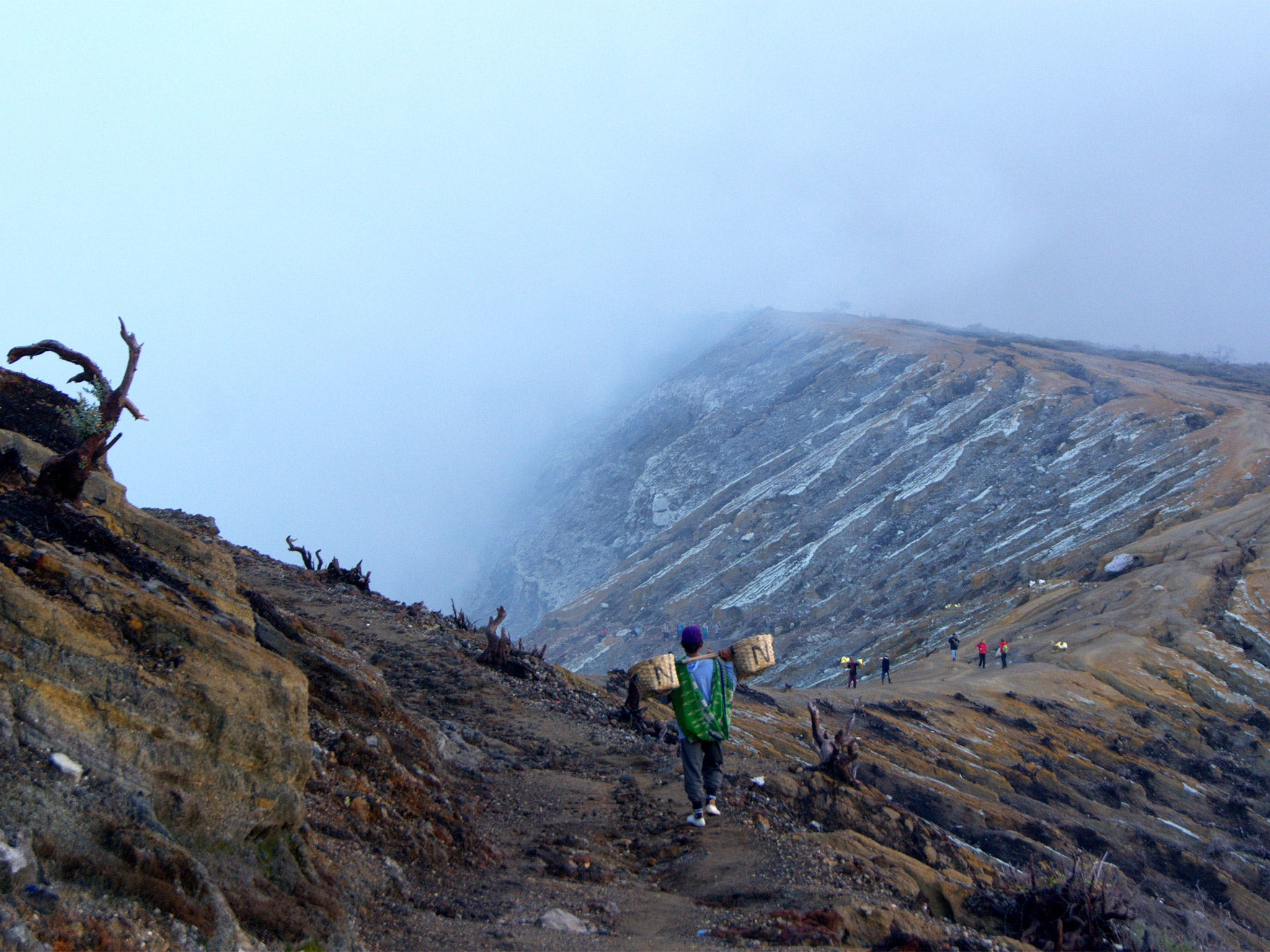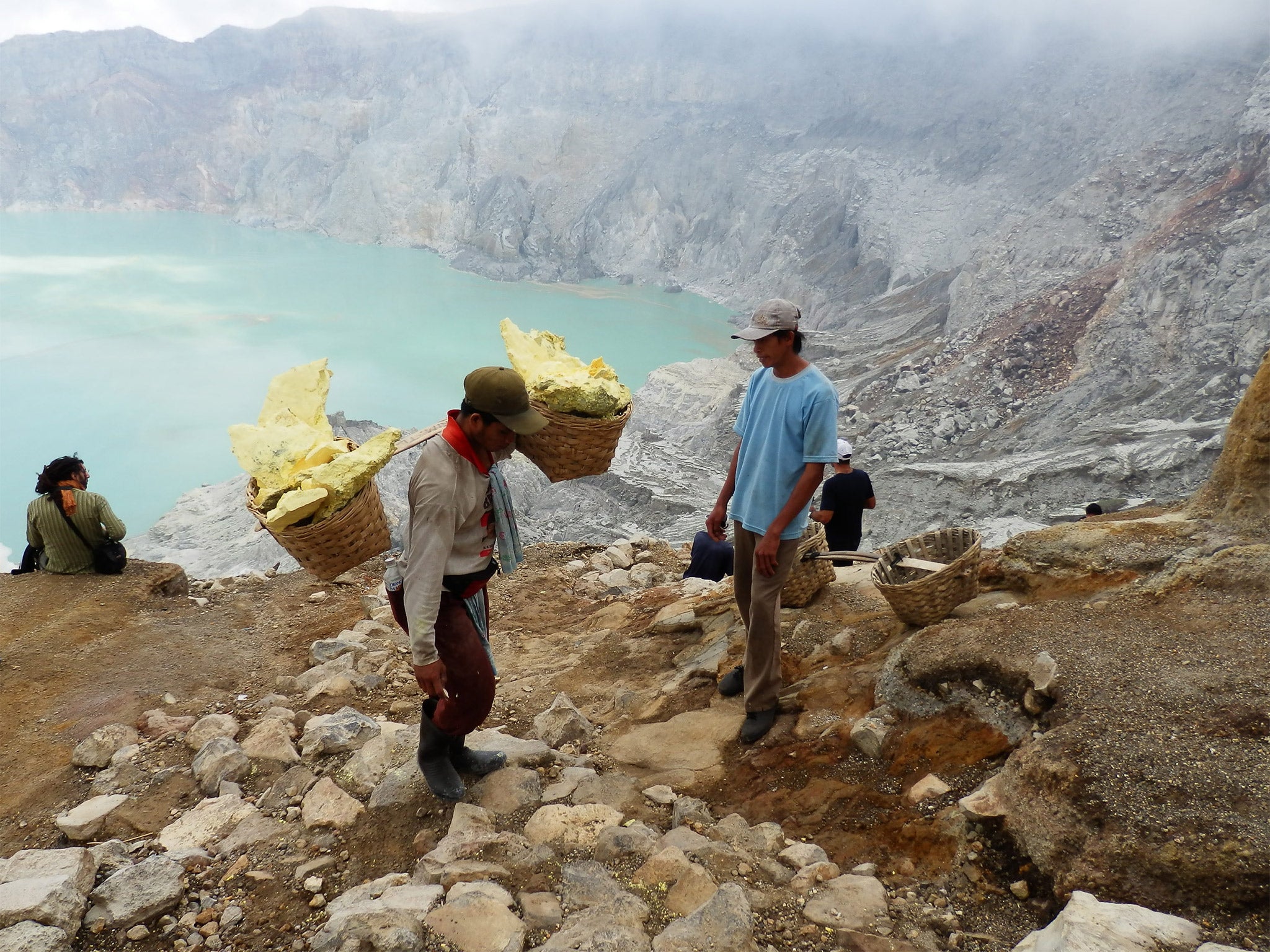The Independent's journalism is supported by our readers. When you purchase through links on our site, we may earn commission.
Playing with fire: The perilous practice of sulphur mining
Dozens of volcanoes form the backbone of the Indonesian island of Java, many of them active. Heather Carswell ventured up one

Your support helps us to tell the story
From reproductive rights to climate change to Big Tech, The Independent is on the ground when the story is developing. Whether it's investigating the financials of Elon Musk's pro-Trump PAC or producing our latest documentary, 'The A Word', which shines a light on the American women fighting for reproductive rights, we know how important it is to parse out the facts from the messaging.
At such a critical moment in US history, we need reporters on the ground. Your donation allows us to keep sending journalists to speak to both sides of the story.
The Independent is trusted by Americans across the entire political spectrum. And unlike many other quality news outlets, we choose not to lock Americans out of our reporting and analysis with paywalls. We believe quality journalism should be available to everyone, paid for by those who can afford it.
Your support makes all the difference.There is a noise on the path behind us. I turn, swinging the light of my torch directly into a man’s face. Anywhere else in the world I would be alarmed, after all, it is the middle of the night and my friend and I are on a forest-lined track, miles from civilisation. However, the man, who greets us with a wide smile, is part of the reason why we are here, at the base of the Ijen volcano in East Java. We are in one of the few places in the world where travellers can witness the near-extinct practice of volcanic sulphur mining.
The island of Java sits at the heart of Indonesia, one of the most volcanic nations on earth, made up of some 17,000 islands. Java’s dense population – it is the world’s most populous island, home to more than half of Indonesia’s 250 million residents – and notorious pollution mean that it is often dismissed by travellers, but away from the urban pockets is a string of volcanoes stretching the length of the island, 45 of them active and plenty offering activities for the adventurous tourist.
Almost within sight of Bali, Ijen volcano offers the opportunity to share the 3km path to the crater with miners, watching in wonder as they make the twice-daily trip to the summit, where they descend into the steaming crater and extract chunks of sulphur. It is channelled from the heart of the volcano through pipes, in which volcanic gasses condense to produce dark red, molten sulphur. The sulphur spews out of the pipe where it cools and solidifies, turning bright yellow in the process. The miners then break it into chunks and carry it in wicker baskets up to the crater rim and down the side of the volcano to be weighed. The sulphur is used in the paper industry, to bleach sugar and to make matches and fertiliser.
The starting point of the trek is Pos Paltuding, in the middle of the Ijen Plateau, a sparsely populated highland area on the eastern tip of the island. There’s little at Pos Paltuding beyond a basic shelter where you can spend the night. Accommodation options close to the trek are limited to budget homestays; for mid-range options you need to stay further afield, such as along the east coast. My base is Arabica Homestay, on a nearby coffee plantation, from which we make a sleepy departure for our ascent at 4.30am – the turquoise acid crater lake is best seen in the early morning, before cloud descends and obscures the view.
The path is good, a couple of metres wide in places, but steep in parts. It is minutes before we meet the first miner; he is keen to know where we are from and if he can practise his English on us. We are happy to oblige and as we pant our way up the steep trail there is a steady flow of conversation with our new friend and some of the other miners, who pause briefly as they stride past at twice our speed. I ask them about the physical demands and dangers of the job, which they shrug off nonchalantly, keen to talk instead about life in London.

We are a quarter of the way up when we are greeted by a spectacular sunrise which allows us our first glimpse of the stunning Ijen Plateau. Alpine forest stretches over hills and dormant volcanoes as far as the eye can see, while a gang of gibbons breaks the silence as they swing noisily through the trees overhead.
After 90 minutes, the forest clears and we emerge at the lip of the crater. The acid lake, Kawah Ijen, is, frustratingly, hidden behind the clouds of sulphur fumes which billow in our direction. However, the sight is nonetheless impressive; a vast and barren crater rim dotted with miners who are weighed down with baskets filled with bright yellow chunks of sulphur.
As I move closer in towards the crater, the eggy stench hits me. Our miner friend grins and signals for me to cover my mouth and nose with a scarf. He offers to take me down into the crater to see where the sulphur deposits are mined but the fumes are overpowering so I decline. The fumes further down are so noxious that even the miners, who have no protection beyond a face scarf, only enter it for 15 minutes at a time. We say our goodbyes and I watch him amble down the path. He quickly disappears into the smoke.
The eruption of Java’s Mount Kelud in February earlier this year was a reminder, if one was needed, of the mighty power of volcanoes. Seeing first-hand the highly dangerous conditions that the miners work in is sobering. My respect is only amplified when we make our way back down the slope. Every miner we pass as they make their way up for the second time that day gives us a smile or an enthusiastic “good morning”; an experience as alien to a Londoner like me as Ijen itself.
Getting there
Jakarta is the main international airport. It is served from Gatwick by Garuda (020 7467 8640; garudaindonesia.co.uk) via Amsterdam. Airlines such as Qatar (0333 320 2454; qatarairways.com), Emirates (01625 445 200; emirates.com), Etihad (020 3450 7300; etihadairways.com), Singapore Airlines (0844 800 2380; singaporeair.com) and Malaysia Airlines (0871 423 9090; malaysiaairlines.com) fly from the UK via their respective hubs.
Bamboo Travel (020 7720 9285; bambootravel.co.uk) offers a 16-day tour which takes in the highlights of Java and neighbouring Bali, including Ijen Volcano. Tours depart from Heathrow and cost £2,395.
Getting around
One of the main starting points for tours to the Ijen Plateau is the city of Jogjakarta in Central Java. Viavia Jogya (00 62 274 386557; viaviajogja.com) offers a four-day tour which includes Mount Bromo and the Ijen Volcano. Alternatively, you can arrange your own private transport at any of Jogjakarta’s many travel centres.
Staying there
Arabica Homestay (00 62 813 3638 9597; arabica.homestay@gmail.com) is situated in the village of Sempol, 13km from the Ijen volcano. Double rooms start at 190,000 rupiah (£10).
Join our commenting forum
Join thought-provoking conversations, follow other Independent readers and see their replies
Comments